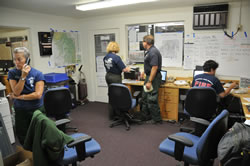National Cohesive Wildland Fire Management Strategy Success Story
Joint Information Center Operation during the Motor Fire
Yosemite National Park, California
Cohesive Strategy - Response to Wildfire
2011

Yosemite National Park Joint Information Center during the Motor Fire, August 26, 2011.
Early in the afternoon of August 25, 2011, a typical hot, busy day in Yosemite National Park, a call came to the park dispatch center. A recreational vehicle leaving the park on Highway 140 was on fire. The fire spread quickly from the RV to the roadway then jumped the road into the canyon area and soon crossed the main fork of the Merced River. Dispatch reports giving constant size-ups and rates of spread indicated that the fire was tripling in size every five minutes.
Although the fire was outside the park boundaries and on U.S. Forest Service lands, Yosemite National Park fire crews were the first to respond and were subsequently involved with the Motor Fire for the next two weeks. The Yosemite National Park Fire Information and Education Specialist heard the first dispatch and subsequently began calling in information resources. Recognizing the level of the call, and seeing the plume from Wawona, it became evident that Yosemite would soon be inundated with phone calls from visitors, employees, and residents in the surrounding areas.
Within one hour of the first dispatch calls, Yosemite National Park Fire Information had established a small Joint Information Center (JIC). Dispatch began routing all fire-related calls to the center, which was staffed with park fire information officers. The center was operational and staffed 24 hours a day for the first three days, then 20 hours a day for the next two days.
The established JIC received over 2400 calls during the next five days. Callers received timely information and answers to their questions. Many seemed greatly surprised to hear a live voice when they called.
As the fire spread and the needs evolved, fire information officers were assisted by interpretive rangers. As the number of center personnel grew, the capacity to provide information for other agencies and venues increased. The JIC would be delegated to handle fire information calls to Mariposa County, and both the Sierra and Stanislaus National Forests. Information officers created an electronic resource list enhancing information efforts through email, web pages, social media, and other media venues. Communications were established with management staff, gateway communities, visitor centers, chambers of commerce, elected officials, law enforcement, and visitors, strengthening information efforts on the Motor Fire.
Information officers established a presence in communities and assisted with subsequent evacuations. The information officers’ presence and timely information updates made the necessary evacuations calm and orderly.
Through a delegation of authority, the incident management team on the Motor Fire requested that Yosemite National Park continue to handle and staff the JIC over the course of the fire. To assure coordination of the information efforts, Yosemite’s fire information manager participated in all team briefings and planning meetings, facilitating the flow of a unified message between all involved agencies. A high priority for the park was to maintain open and timely information between the park superintendent, its public information office, and the JIC.
The Joint Information Center coordinated with the Type II team on the fire as well as with the surrounding fire agencies. Having set up communications rapidly, anticipating the calls and the level of questions, and having relationships with many of the callers, created a high level of trust. The center received frequent updates from the fire team and from field information officers. Particularly when evacuation orders were made, callers were able to make decisions based on that timely and accurate information that was provided to them.
The Motor Fire provided an educational opportunity to explain and demonstrate the effectiveness of a JIC. In addition to sessions about the purpose of the Joint Information Center, topics such as fire behavior, fuel models, the incident command system (ICS), strategy and tactics, and other information increased the knowledge base of those directly in contact with the public.
Although the Motor Fire was not within the jurisdiction of Yosemite National Park, this fire affected many employees living in the area. Road closures and travel delays also affected visitors. By having timely information available through the JIC, fire information boards posted wherever smoke was visible and along all major roadways and entrance stations, and information officers present in the affected communities, , the impacts to most were minor.
The concept of a Joint Information Center proved to be an asset to Yosemite National Park, Mariposa County, The Sierra National Forest, and the Stanislaus National Forest. This fire caused national attention with its location adjacent to Yosemite, one of the nation’s crown jewel parks. There was open and direct communication with boards of supervisors, the media, Congressional staff, gateway partners and local businesses. The Motor Fire served as an example of how positive communications, partnerships and efforts to work together can serve as an information model for future fire events.
Contact
Gary Wuchner, Fire Information and Education Specialist
Email: Gary_Wuchner@nps.gov
Phone: (209) 375-9574 or 372-0480
Keywords: Joint Information Center, Partnerships, Collaboration, Unified Messages